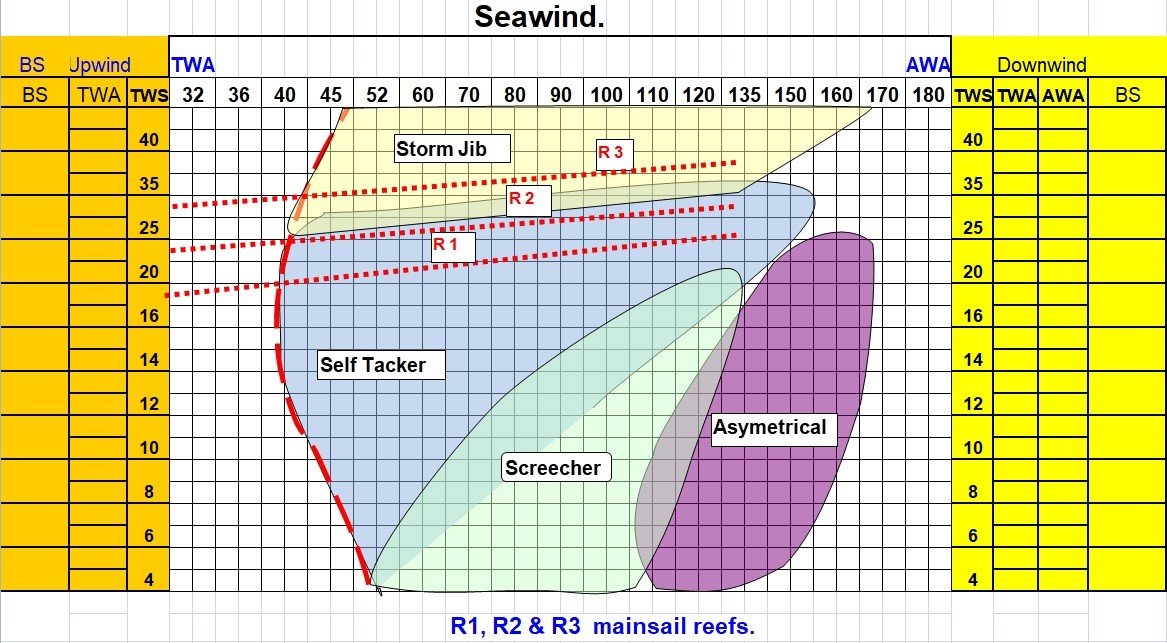RANGES OF SAILS
All sails have wind ranges. Generally, we engineer the sail to be fit for use on your boat. If anything, we overbuild the sails slightly. Two questions come into this: how long do you want the sails to last, and how often will you sail?
On a multihull, the righting moment is high. This means the boats are stiff and don’t heel much, which creates power enabling the boats to go fast. This, in turn, increases the apparent wind. If you have 15 knots of true wind and you do 8 knots of boat speed, then you have 23 knots of wind across the deck.
15 knots of wind is generally considered a nice sailing breeze, but, on a multihull, you have to think of reducing the sail area much sooner. If you overload the boat with power, it will become harder to sail and more uncomfortable. Plus, you wear things out more quickly, the boat sails less efficiently, and generally you tend to be slower. Nearly every sailor I know has experienced the following scenario.
A nice pleasant sail and you don’t realise the wind is increasing. You get more power and lots more spray over the deck, the boat is harder to control BUT you are having fun. After a while you decide to reef, the boat settles down, you go faster, and it is much more comfortable.
I guess what we need to do is understand a set of wind strengths and angles and reef accordingly.
RULE OF THUMB – REEF BEFORE YOU NEED TO!
Here is a chart that we worked out for the SW1600. The same rules apply to most boats.
Reef 1 – 18 knots true wind
Reef 2 – 23 knots true wind
Reef 3 – 28 knots true wind
Add your boat speed to this to get an approximate apparent wind.
CROSSOVER CHART
The vertical scales tell you the true wind, and the horizontal scales the true wind angle. You then simply look at the wind and your course to get an accurate reflection of what sail you should be using. As you can see, it’s hard for one sail to cover a big wind range. By using the chart, your sails will always be used correctly, and you will get optimum life from them.

WHAT SAILS DO I CHOOSE? WHAT SAILING ARE YOU DOING?
This is the million dollar question! Easy to ask but hard to answer. Generally, we like to get the owner to think of their sailing over the next five years. It sounds a long time but is usually realistic. You have probably bought the boat with some term in mind. Questions we would normally discuss are:
- Are you coastal or blue-water cruising?
- Short or long-distance racing?
- What crew will you sail with? A couple is different to fully crewed.
- Will you cruise along the coast but then decide to cross oceans?
- Will you club race but then want to serious race?
The answers to these questions help us look at the fabrics in the sails and what sails you will need. Cruising, you may be happy with a main and jib. A racer may want asymmetrical and screeches.
Once we ascertain the use of the boat, it is much easier to define a budget. The cheapest sails won’t always help you achieve your objectives for the boat.
CARE OF SAILS
Sails are often neglected. They are, however, the engine of the boat, and like any engine they should be properly cared for. Points to look for are:
- Never let the sails flap unnecessarily. Flapping will damage and weaken the cloth.
- Use leech and foot lines to control leech flapping.
- Protect from UV damage. UV and flapping are two of the biggest killers of sails.
- Check for chafe and wear and tear. Little issues can become big issues, usually at the wrong time!
- ALWAYS ease the foot outhaul before lowering the mainsail. If boom angle drops too much, you can overload lower sail slides.
- Have a sail repair kit on board.
We can supply a sail maintenance article to anyone who would like this.
You can also find this article in our latest Seawind Cruising Club Issue 2 magazine. In this issue, we also cover a lot of stories from Seawind owners, sailing tips and the latest news about Seawind catamarans.
